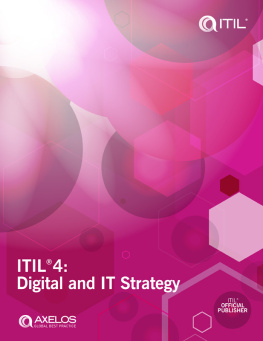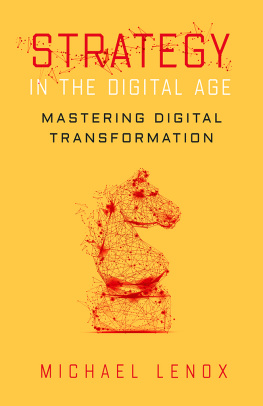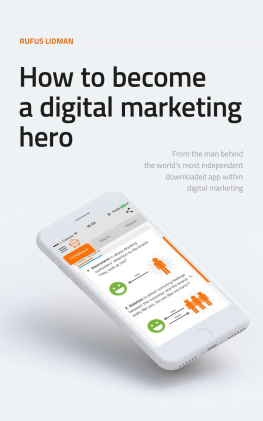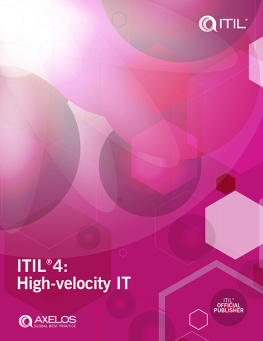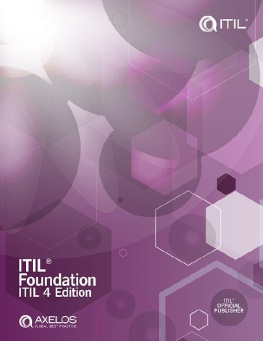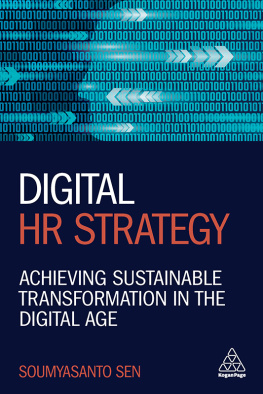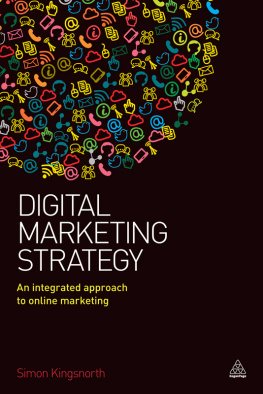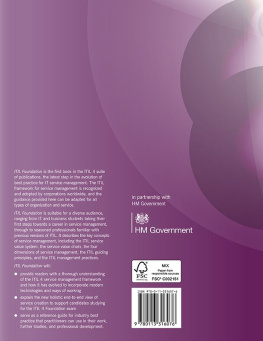Table of Contents
Guide

ITIL 4: Digital and IT Strategy


Published by TSO (The Stationery Office), part of Williams Lea, and available from:
Online
www.tsoshop.co.uk
Mail, Telephone, Fax & E-mail
TSO
PO Box 29, Norwich, NR3 1GN
Telephone orders/General enquiries: 0333 202 5070
Fax orders: 0333 202 5080
E-mail:
Textphone 0333 202 5077
TSO@Blackwell and other Accredited Agents
AXELOS
Full details on how to contact AXELOS can be found at:
https://www.axelos.com
For further information on qualifications and training accreditation, please visit:
https://www.axelos.com/certifications https://www.axelos.com/find-a-training-provider
For all other enquiries, please email:
Copyright AXELOS Limited 2020
All rights reserved. No part of this publication may be reproduced in any form or by any means without permission in writing from AXELOS Limited.
Applications to reuse, reproduce or republish material in this publication should be sent to the licensing team at: Registered office address: 30 Berners Street, London, England, W1T 3LR
AXELOS, the AXELOS logo, the AXELOS swirl logo, AgileSHIFT, ITIL, MoP, M_o_R, MoV, MSP, P3M3, P3O, PRINCE2, PRINCE2 Agile, and RESILIA are registered trade marks of AXELOS Limited.
Figure 2.3: Reproduced under Creative Commons https://medium.com/wardleymaps
Figure 2.9: Reproduced with permission of Andrew Campbell from Campbell, A., Gutierrez, M. and Lancelott, M. (2017) Operating Model Canvas. Van Haren Publishing
Figure 3.3: Adapted from an original table found in the Digital Transformation Study conducted by the MIT Center for Digital Business and Capgemini Consulting (2011)
Figure 5.3: Reproduced with permission from the Barrett Values Centre
Figure 7.3: Adapted with permission from Perdoo https://www.perdoo.com/the-ultimate-okr-guide/
Figure 8.3: The Cynefin framework is licensed under the Creative Commons Attribution-Share Alike 3.0 unported licence (https://creativecommons.org/licenses/by-sa/3.0/) from https://commons.wikimedia.org/wiki/File:Cynefin_as_of_1st_June_2014.pnghttps://commons.wikimedia.org/wiki/File:Cynefin_as_of_1st_June_2014.png
Figure 8.4: Adapted from Rother, M. Toyota Kata Practice Guide. Licensed under the Creative Commons Attribution 3.0 unported licence (https://creativecommons.org/licenses/by/3.0/https://creativecommons.org/licenses/by/3.0/) from http://www-personal.umich.edu/~mrother/Supporting_Materials.htmlhttp://www-personal.umich.edu/~mrother/Supporting_Materials.html
Figure 12.2: Reproduced from Kolbjrnsrud, V. Collaborative organizational forms: on communities, crowds, and new hybrids. J Org Design 7, 11 (2018). https://doi.org/10.1186/s41469-018-0036-3 under the Creative Commons License (http://creativecommons.org/licenses/by/4.0/)
First edition 2020
ISBN 9780113316489
Printed in the United Kingdom for The Stationery Office
Material is FSC certified and produced using ECF pulp, sourced from fully sustainable forests.
J003712027 08/20 C1.5
List of figures
List of tables
Foreword
At this new stage in the development of the IT industry, AXELOS is delighted to present ITIL 4, the latest step in the evolution of IT best practice. By building on our experience and bringing fresh and forward-looking thinking to the marketplace, ITIL 4 equips your business to deal with the challenges currently faced by the industry.
The adoption of ITIL as the most widely used guidance in the world on IT and service management will continue with ITIL 4. It ensures continuity with existing ways of working (where service management is already successful) by integrating modern and emerging practices with established and proven know-how. ITIL 4 also provides guidance on these new methods to help individuals and organizations to see their benefits and move towards using them with confidence, focus, and minimal disruption.
ITIL 4s holistic approach raises the profile of service management in organizations and industries, setting it within a more strategic context. Its focus tends to be on end-to-end product and service management, from demand to value.
ITIL 4 is the result of a great deal of global research and development work across the IT and service management industries; this work has involved active practitioners, trainers, consultants, vendors, technicians, and business customers. The architect team has collaborated with the wider stakeholders and users of ITIL to ensure that the content meets the modern requirements of continuity, innovation, flexibility, and value.
ITIL training provides individuals with a structured approach for developing their competencies in the current and future workplace. The accompanying guidance also helps organizations to take advantage of the new and upcoming technologies, succeed in making their digital transformations, and create value as needed for themselves and their customers.
ITIL4: Digital and IT Strategy focuses on the alignment of digital business strategy with IT strategy, adding a new perspective to the ITIL suite and elevating the discussion around ITIL concepts to a strategic level among business leaders and those aspiring to lead. It also covers how disruption from new technologies is impacting organizations in every industry and how business leaders are responding.
Welcome to the new generation of IT best practice!

Mark Basham
CEO, AXELOS Global Best Practice
Preface
Digital technology has ushered in a new age of business, society, and economy. Things work differently today than they did just 20 years ago, and they will continue to change at unprecedented rates.
But as different as the world is, many things have not changed. The best and worst of human nature finds expression through digital technology. The principles of business and commerce remain very much the same as they have for decades, if not centuries. An organization that embraces the changes brought by digital technology will be even more successful if it remembers that it exists for the benefit of the humans it serves and gainfully employs, and the environment in which it operates.
While digital technology creates new opportunities and capabilities, many of the principles and practices that have been learned over decades are just as important as ever, if not more so. Governance, leadership, service, and quality are not uniquely digital issues. Simply putting the word digital in front of them will not absolve any organization or leader from having to define and implement them.
Digital technologies may make that task easier, but experience has shown that they also introduce more levels of complexity, volatility, and uncertainty. In most cases, the best way to achieve excellence is to rely on those things that will last beyond the most recent wave of technology innovation, and not to assume that new technology, having solved its own problems, will be able to solve yours.
Digital and IT strategy is a means for real-world organizations to find better ways of meeting the needs of real-life communities using a combination of existing and emerging technologies. Some of these will require new practices and changes to the prevailing culture, but many will rely on existing practices and approaches.

